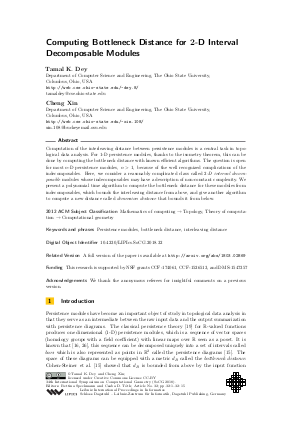Computing Bottleneck Distance for 2-D Interval Decomposable Modules
Authors Tamal K. Dey, Cheng Xin
-
Part of:
Volume:
34th International Symposium on Computational Geometry (SoCG 2018)
Part of: Series: Leibniz International Proceedings in Informatics (LIPIcs)
Part of: Conference: Symposium on Computational Geometry (SoCG) - License:
 Creative Commons Attribution 3.0 Unported license
Creative Commons Attribution 3.0 Unported license
- Publication Date: 2018-06-08
File

PDF
LIPIcs.SoCG.2018.32.pdf
- Filesize: 0.8 MB
- 15 pages
Document Identifiers
Subject Classification
Keywords
- Persistence modules
- bottleneck distance
- interleaving distance
Metrics
- Access Statistics
-
Total Accesses (updated on a weekly basis)
0Document
0Metadata
Abstract
Computation of the interleaving distance between persistence modules is a central task in topological data analysis. For 1-D persistence modules, thanks to the isometry theorem, this can be done by computing the bottleneck distance with known efficient algorithms. The question is open for most n-D persistence modules, n>1, because of the well recognized complications of the indecomposables. Here, we consider a reasonably complicated class called 2-D interval decomposable modules whose indecomposables may have a description of non-constant complexity. We present a polynomial time algorithm to compute the bottleneck distance for these modules from indecomposables, which bounds the interleaving distance from above, and give another algorithm to compute a new distance called dimension distance that bounds it from below.
Cite As Get BibTex
Tamal K. Dey and Cheng Xin. Computing Bottleneck Distance for 2-D Interval Decomposable Modules. In 34th International Symposium on Computational Geometry (SoCG 2018). Leibniz International Proceedings in Informatics (LIPIcs), Volume 99, pp. 32:1-32:15, Schloss Dagstuhl – Leibniz-Zentrum für Informatik (2018)
https://doi.org/10.4230/LIPIcs.SoCG.2018.32
BibTex
@InProceedings{dey_et_al:LIPIcs.SoCG.2018.32,
author = {Dey, Tamal K. and Xin, Cheng},
title = {{Computing Bottleneck Distance for 2-D Interval Decomposable Modules}},
booktitle = {34th International Symposium on Computational Geometry (SoCG 2018)},
pages = {32:1--32:15},
series = {Leibniz International Proceedings in Informatics (LIPIcs)},
ISBN = {978-3-95977-066-8},
ISSN = {1868-8969},
year = {2018},
volume = {99},
editor = {Speckmann, Bettina and T\'{o}th, Csaba D.},
publisher = {Schloss Dagstuhl -- Leibniz-Zentrum f{\"u}r Informatik},
address = {Dagstuhl, Germany},
URL = {https://drops.dagstuhl.de/entities/document/10.4230/LIPIcs.SoCG.2018.32},
URN = {urn:nbn:de:0030-drops-87453},
doi = {10.4230/LIPIcs.SoCG.2018.32},
annote = {Keywords: Persistence modules, bottleneck distance, interleaving distance}
}
Author Details
References
- Michael Atiyah. On the krull-schmidt theorem with application to sheaves. Bulletin de la Société Mathématique de France, 84:307-317, 1956. URL: http://eudml.org/doc/86907.
-
Ulrich Bauer and Michael Lesnick. Induced matchings of barcodes and the algebraic stability of persistence. In Proceedings of the Thirtieth Annual Symposium on Computational Geometry, SOCG'14, pages 355:355-355:364, 2014.

-
Silvia Biasotti, Andrea Cerri, Patrizio Frosini, and Daniela Giorgi. A new algorithm for computing the 2-dimensional matching distance between size functions. Pattern Recognition Letters, 32(14):1735-1746, 2011.

-
Håvard Bjerkevik. Stability of higher-dimensional interval decomposable persistence modules. arXiv preprint arXiv:1609.02086, 2016.

-
Håvard Bjerkevik and Magnus Botnan. Computational complexity of the interleaving distance. arXiv preprint arXiv:1712.04281, 2017.

- Magnus Botnan, Justin Curry, and Elizabeth Munch. The poset interleaving distance, 2016. URL: https://jointmathematicsmeetings.org/amsmtgs/2180_abstracts/1125-55-1151.pdf.
-
Magnus Botnan and Michael Lesnick. Algebraic stability of zigzag persistence modules. arXiv preprint arXiv:1604.00655, 2016.

-
Peter Bubenik and Jonathan Scott. Categorification of persistent homology. Discrete & Computational Geometry, 51(3):600-627, 2014.

-
Gunnar Carlsson and Afra Zomorodian. The theory of multidimensional persistence. Discrete & Computational Geometry, 42(1):71-93, Jul 2009.

-
Andrea Cerri, Barbara Di Fabio, Massimo Ferri, Patrizio Frosini, and Claudia Landi. Betti numbers in multidimensional persistent homology are stable functions. Mathematical Methods in the Applied Sciences, 36(12):1543-1557, 2013.

- Andrea Cerri and Patrizio Frosini. A new approximation algorithm for the matching distance in multidimensional persistence. Technical report, February 2011. URL: http://amsacta.unibo.it/2971.
-
Frédéric Chazal, David Cohen-Steiner, Marc Glisse, Leonidas Guibas, and Steve Oudot. Proximity of persistence modules and their diagrams. In Proceedings of the Twenty-fifth Annual Symposium on Computational Geometry, SCG '09, pages 237-246, 2009.

-
Frédéric Chazal, Vin de Silva, Marc Glisse, and Steve Oudot. The structure and stability of persistence modules. arXiv preprint arXiv:1207.3674, 2012.

-
Jérémy Cochoy and Steve Oudot. Decomposition of exact pfd persistence bimodules. arXiv preprint arXiv:1605.09726, 2016.

-
David Cohen-Steiner, Herbert Edelsbrunner, and John Harer. Stability of persistence diagrams. Discrete &Computational Geometry, 37(1):103-120, 2007.

- William Crawley-Boevey. Decomposition of pointwise finite-dimensional persistence modules. Journal of Algebra and Its Applications, 14(05):1550066, 2015. URL: http://dx.doi.org/10.1142/S0219498815500668.
-
Vin de Silva, Elizabeth Munch, and Amit Patel. Categorified reeb graphs. Discrete & Computational Geometry, 55(4):854-906, Jun 2016.

- Tamal Dey and Cheng Xin. Computing bottleneck distance for 2-d interval decomposable modules, 2018. URL: http://arxiv.org/abs/1803.02869.
-
Herbert Edelsbrunner and John Harer. Computational Topology: An Introduction. Applied Mathematics. American Mathematical Society, 2010.

-
Michael Kerber, Dmitriy Morozov, and Arnur Nigmetov. Geometry helps to compare persistence diagrams. Journal of Experimental Algorithmics (JEA), 22(1):1-4, 2017.

-
Claudia Landi. The rank invariant stability via interleavings. arXiv preprint arXiv:1412.3374, 2014.

-
Michael Lesnick. The theory of the interleaving distance on multidimensional persistence modules. Foundations of Computational Mathematics, 15(3):613-650, 2015.

-
Klaus Lux and Magdolna Sźoke. Computing decompositions of modules over finite-dimensional algebras. Experimental Mathematics, 16(1):1-6, 2007.

-
Steve Oudot. Persistence theory: from quiver representations to data analysis, volume 209. American Mathematical Society, 2015.

-
Amit Patel. Generalized persistence diagrams. arXiv preprint arXiv:1601.03107, 2016.

-
Carry Webb. Decomposition of graded modules. Proc. American Math. Soc., 94(4):565-571, 1985.

